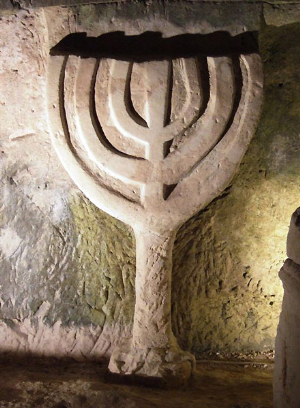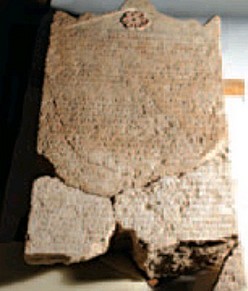

75 inch tall menorah at Beit Shearim
Leave it to the colonialist Israel Antiquities Authority (the vaunted IAA) to continue to play a role in the formation and enactment of Israel’s colonial-national historical imagination by presenting yet another of all the countless hard-to-refute archaeological findings that shape the spatial foundations and ideological contours of Israel’s settler nationhood and help to facilitate its territorial extension, appropriation and gradual reconfiguration (borrowed liberally from Nadia Abu El-Haj, now tenured professor at Columbia University).
How did they commit this evil deed? They publicly presented, on the eve of Hannukah, an inscription found on a stele in the caves of Beit Guvrin, 30 minutes outside Jerusalem.
The Stele was reconstituted after some fascinating puzzle-like repairs that took place when a researcher, Dov Gera, who had been asked for help by the archaeologist, Ian Stern, who had found two of the broken pieces from the Stele, realized that if he took a piece from Michael Steinhardt’s collection, which happened to be on display in Israel, and connected it to the other two pieces and then to the larger stele section that was in the Israel Museum, that they would make a whole inscribed tablet.


Maccabean Era Temple Tax Stele
Of course, it is this Jewish Revolt against the Seleucids which the non-Jews who pretend to be Jews and have colonized Israel celebrate – and which the real Jews who are the Palestinians no longer celebrate – in the holiday of Hannukah (that was borrowed from Shlomo Sand, a tenured professor at Tel Aviv University).
Just kidding! Sand and Abu El Haj are examples of how free speech and academic freedom are used to pervert history through the use of politics, even as they complain and claim that it’s the other way around. Kudos to Gera, Stern, the IAA, Michael Steinhardt and the folks who dug and fixed up the ancient site at Beit Shearim and those who continue to make Beit Guvrin a fascinating destination (Stern found two pieces of the stele in the “archeology for a day” program they hold at Beit Guvrin. I’ve never done it, but I’ve seen visitors dig and sift through what they find on a day’s archaeological outing on location there. They found these in that touristy program! How about that?!).
Oh, and by the way, the IDF’s initial report on their investigations of the 36 incidents listed in the Goldstone Report as Israeli war crimes is that 30 of them are “baseless accusations” and 6 may be true but appear to be operational errors.
I recommend reading both articles.
Happy Hannukah!
Happy Chanukah!
Happy Hanukkah!
Happy Channukah!
Happy Chanuka
Happy Hannuka
Happy Hanukka
Happy Chanuka






3consent
Here is the best locksmith in London and Surroundings!
bismil escort bayan sitesi telefon numaras?
karamürsel escort bayan sitesi telefon numaras?
Title
[…]one of our visitors lately advised the following website[…]
You have a great site and content, I’m glad you liked it here. 98860345
What computer software were computers using before Microsoft was invented? I googled it and couldn’t find any info on it. Thanks and no jokes or dissing please..
Title
[…]The facts mentioned in the write-up are some of the most effective readily available […]
Title
[…]The details talked about inside the post are some of the most effective readily available […]
Title
[…]although web-sites we backlink to below are considerably not connected to ours, we feel they may be essentially really worth a go by means of, so possess a look[…]
Title
[…]here are some hyperlinks to websites that we link to due to the fact we assume they’re really worth visiting[…]
Title
[…]Sites of interest we’ve a link to[…]
Title
[…]Wonderful story, reckoned we could combine a number of unrelated information, nonetheless really worth taking a look, whoa did a single learn about Mid East has got far more problerms as well […]
uluslararas? evden eve nakliyat
Title
[…]please go to the internet sites we adhere to, such as this a single, as it represents our picks through the web[…]
Title
[…]check beneath, are some entirely unrelated sites to ours, nevertheless, they may be most trustworthy sources that we use[…]
Title
[…]that could be the end of this report. Here you will uncover some web pages that we consider you’ll enjoy, just click the hyperlinks over[…]
Title
[…]below you’ll come across the link to some web-sites that we consider it is best to visit[…]
Title
[…]Every when in a while we pick out blogs that we study. Listed below would be the newest internet sites that we pick out […]
Title
[…]that may be the finish of this report. Here you’ll discover some sites that we assume you’ll appreciate, just click the hyperlinks over[…]
Title
[…]Sites of interest we have a link to[…]
Title
[…]check beneath, are some completely unrelated sites to ours, even so, they’re most trustworthy sources that we use[…]